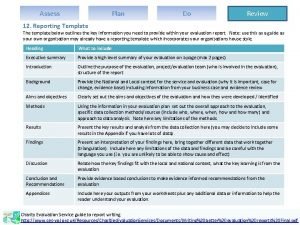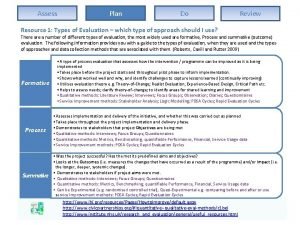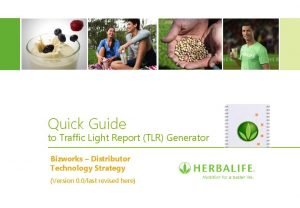Assess Plan Do Review 12 Reporting Template The



- Slides: 3

Assess Plan Do Review 12. Reporting Template The template below outlines the key information you need to provide within your evaluation report. Note: use this as a guide as your own organisation may already have a reporting template which incorporates your organisations house style. Heading What to include Executive summary Provide a high level summary of your evaluation on a page (max 2 pages) Introduction Outline the purpose of the evaluation, project/evaluation team (who is involved in the evaluation), structure of the report Background Provide the National and Local context for the service and evaluation (why it is important, case for change, evidence base) including information from your business case and evidence review Aims and objectives Clearly set out the aims and objectives of the evaluation and how they were developed / identified Methods Using the information in your evaluation plan set out the overall approach to the evaluation, specific data collection methods/sources (include who, where, when, how and how many) and approach to data analysis. Note here any limitations of the methods. Results Present the key results and analysis from the data collection here (you may decide to include some results in the Appendix if you have lots of data). Findings Present an interpretation of your findings here, bring together different data that work together (triangulation). Include here any limitations of the data and findings and be careful with the language you use (i. e. you are unlikely to be able to show cause and effect) Discussion Relate how the key findings fit with the local and national context, what the key learning is from the evaluation. Conclusion and Recommendations Provide evidence based conclusions to make evidence informed recommendations from the evaluation Appendices Include here your outputs from your worksheets plus any additional data or information to help the reader understand your evaluation. Charity Evaluation Service guide to report writing http: //www. ces-vol. org. uk/Resources/Charities. Evaluation. Services/Documents/Writing%20 better%20 evaluation%20 reports%20 Final. pdf

Assess Plan Do Review 13. Action Planning template Once you have reviewed the results of your evaluation (and taken account of limitations of these findings) you can use these to make your recommendations for going forward based on the evidence. Ideally these would be reviewed by and agreed with your project team and tested out with your key stakeholders. The next step is to develop an action plan for implementing these recommendations. Your organisation may already have a standard template for this, however the following is a simple tool. To maximise the impact of your evaluation make sure you use your findings to inform your decision making going forward And identify areas for improvement Recommendation Action Why Who When Risk level / Issues Recommendation from the evaluation specific action to help address the recommendation explanation of why the action will lead to the desired change Lead responsible for delivery Timescale Use your organisations risk matrix Note any risks or issues associated with this activity NHS Scotlands Quality Improvement Hub Guide to Action planning http: //www. qihub. scot. nhs. uk/knowledge-centre/quality-improvement-tools/action-plan. aspx

Assess Plan Do Review 14. Share your findings (Dissemination/Communication) planning template Working with your organisations communications experts and project team draw up a dissemination plan for your evaluation to maximise its impact. Consider who your audience is, what the different approaches are to communicating the messages and the different formats these could be communicated in and by. Where available, build into your project/service communications strategy. Use multiple formats to communicate your findings for the greatest impact and where possible utilise existing forms and channels of communication (engage your communications experts!) Audience Approach Format Who When Risk level / Issues who you are trying to reach e. g. Participants in the study how you are going to reach your audience) e. g. Website, Staff meeting, newsletter what your message will look like) e. g. Report, leaflet, poster etc Lead responsible for delivery Timescale Use your organisations risk matrix Note any risks or issues associated with this activity Better Evaluation blog on infographics http: //betterevaluation. org/blog/infographics_to_make_your_eval_results_go_viral NHS Wirral’s guide to dissemination http: //info. wirral. nhs. uk/document_uploads/evidence-factsheets/19 disseminatethefindings 11052011. pdf





